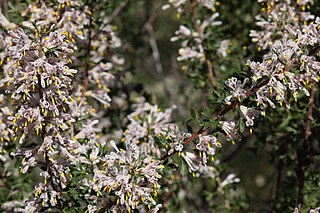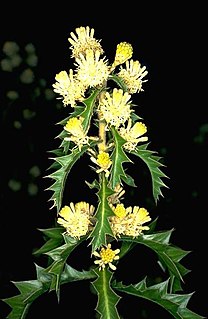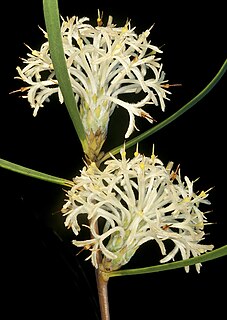
Banksia prolata is a species of bushy shrub that is endemic to Western Australia. It has linear, serrated or pinnatifid leaves, yellow flowers in heads of between 150 and 250, and egg-shaped follicles.

Petrophile linearis, commonly known as pixie mops, is a species of flowering plant in the family Proteaceae and is endemic to southwestern Western Australia. It is a shrub with narrow egg-shaped leaves, the narrower end towards the base, and oval to spherical heads of hairy, greyish-pink or mauve to almost white flowers.

Petrophile biloba, commonly known as granite petrophile, is a species of flowering plant in the family Proteaceae and is endemic to southwestern Western Australia. It is a shrub with pinnately-divided leaves with sharply-pointed tips, and oval heads of hairy, mostly grey to pink flowers.

Hakea cucullata, commonly known as hood-leaved hakea, cup hakea or scallop hakea, is a species of shrub in the family Proteaceae and is endemic to the south-west of Western Australia. An attractive shrub with unusual distinctive foliage and beautiful large pink, red or deep purple scented flowers.

Isopogon uncinatus, commonly known as Albany cone bush, is a species of flowering plant in the family Proteaceae and is endemic to a restricted area near Albany in Western Australia. It is a small shrub with very short stems, linear to egg-shaped leaves with the narrower end towards the base, and spherical heads of yellowish flowers. It is the rarest isopogon and was thought to be extinct until rediscovered in the 1980s.

Petrophile acicularis is a species of flowering plant in the family Proteaceae and is endemic to southwestern Western Australia. It is a low, tufted shrub with cylindrical leaves and oval heads of densely hairy, cream-coloured flowers.

Petrophile brevifolia is a species of flowering plant in the family Proteaceae and is endemic to southwestern Western Australia. It is a shrub with cylindrical, sharply-pointed leaves, and spherical heads of hairy yellow, cream-coloured or white flowers.

Petrophile carduacea is a species of flowering plant in the family Proteaceae and is endemic to southwestern Western Australia. It is a shrub with deeply toothed leaves, and more or less spherical heads of hairy yellow flowers.
Petrophile circinata is a species of flowering plant in the family Proteaceae and is endemic to southwestern Western Australia. It is a low, spreading shrub with pinnately-divided, sharply-pointed leaves, and more or less spherical heads of hairy, white, yellow or cream-coloured flowers.

Petrophile conifera is a species of flowering plant in the family Proteaceae and is endemic to southwestern Western Australia. It is a bushy, much-branched shrub with pinnate, sharply-pointed leaves, and oval heads of hairy, cream-coloured to yellowish white flowers.

Petrophile cyathiforma is a species of flowering plant in the family Proteaceae and is endemic to southwestern Western Australia. It is a small shrub with needle-shaped, sharply-pointed leaves and cup-shaped heads of glabrous, bright yellow flowers.

Petrophile diversifolia is a species of flowering plant in the family Proteaceae and is endemic to southwestern Western Australia. It is a shrub with pinnate, sharply-pointed leaves, and oval heads of densely hairy, white or creamy-white flowers.

Petrophile drummondii is a species of flowering plant in the family Proteaceae and is endemic to southwestern Western Australia. It is a shrub with rigid, pinnate leaves with needle-shaped, sharply-pointed pinnae, and spherical heads of hairy, fragrant, yellow flowers.

Petrophile ericifolia is a species of flowering plant in the family Proteaceae and is endemic to southwestern Western Australia. It is a shrub with cylindrical leaves, and oval to spherical heads of hairy, yellow flowers.
Petrophile filifolia is a species of flowering plant in the family Proteaceae and is endemic to southwestern Western Australia. It is a small shrub with curved, long, needle-shaped leaves and more or less spherical heads of hairy cream-coloured to pale yellow flowers.

Petrophile helicophylla is a species of flowering plant in the family Proteaceae and is endemic to southwestern Western Australia. It is a prostrate, spreading shrub with twisted, needle-like leaves and heads of hairy white to creamy-white or pale pink flowers.

Petrophile heterophylla, commonly known as the variable-leaved conebush, is a species of flowering plant in the family Proteaceae and is endemic to southwestern Western Australia. It is a shrub with variably shaped, sometimes pinnately-divided leaves, and oval heads of silky-hairy, yellow to cream-coloured flowers.
Petrophile juncifolia is a species of flowering plant in the family Proteaceae and is endemic to southwestern Western Australia. It is a small, domed shrub with needle-shaped leaves, and heads of yellow to cream-coloured flowers.
Petrophile phylicoides is a species of flowering plant in the family Proteaceae and is endemic to southwestern Western Australia. It is a shrub with short, needle-shaped, but not sharply-pointed leaves, and more or less spherical heads of glabrous yellow flowers.

Petrophile teretifolia is a species of flowering plant in the family Proteaceae and is endemic to southwestern Western Australia. It is a shrub with needle-shaped but blunt-pointed leaves, and oval to more or less spherical heads of hairy pink to mauve flowers.
















